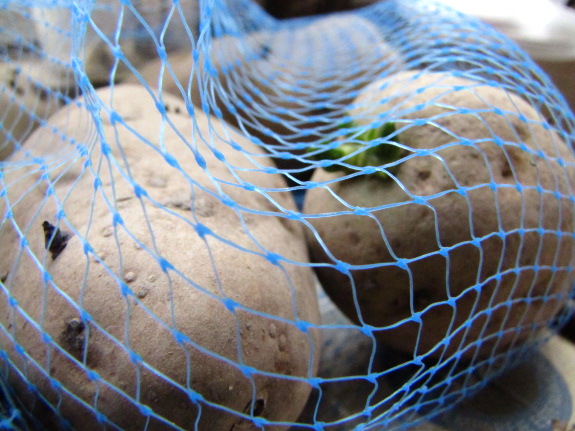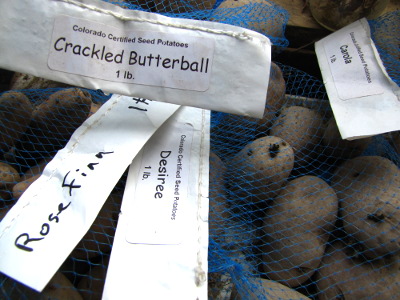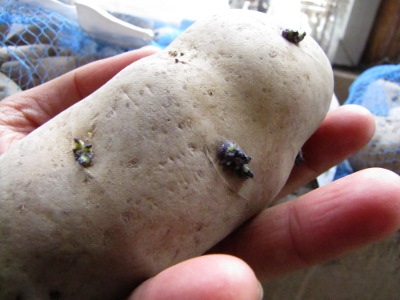
Gourmet potato varieties

One of the best
decisions we made during the early years on the farm was to splurge on
$45 worth of seed garlic. Yes, that sounds like
an excessive amount of money for two pounds of garlic, but the high
quality bulbs grow like crazy and have provided all the garlic we could
eat for the last three years. Meanwhile, we've given away starter
garlic to all and sundry, so I really can't calculate how many pounds
of garlic those first two pounds turned into.
 With that success in mind, I
decided to try out four new varieties of potatoes this spring, even
though the seed potatoes cost $5 to $7.50 per pound at the Potato Garden (from whence the
descriptions below came). Here are the varieties I chose after
reading the descriptions for all 55 types of potatoes offered on their
website:
With that success in mind, I
decided to try out four new varieties of potatoes this spring, even
though the seed potatoes cost $5 to $7.50 per pound at the Potato Garden (from whence the
descriptions below came). Here are the varieties I chose after
reading the descriptions for all 55 types of potatoes offered on their
website:
- Carola - "This yellow
from Germany is heralded by potato lovers as one of the best. Produces
an abundant basket of tubers under each hill. Oblong to round tubers
with smooth yellow skin and flesh that has the texture, moisture and
taste of a new potato even after months of storage in the root cellar.
Boils, bakes, mashes and hashes that are out of this world as well as
makes some of the best scalloped potatoes around. Shows some scab and
disease resistance, also excellent storage qualities."
- Cracked Butterball - "A
2008 German Butterball x Agria cross by Verlin Rockey. This is a great
way to get the German Butterball taste in a larger potato. With a
unique characteristic of a crackled skin, it is easily washed with a
vegetable brush."
- Desiree - "The most
popular “red” potato in Europe. Round to oblong tubers, satin-like
pinkish/red skin and gourmet quality creamy-yellow flesh. Prolific
yields of excellent all-around cooking potatoes. Very resistant to
common diseases. An easy and very reliable gourmet potato to grow."
- Rose Finn Apple Fingerling - "A rosy colored skin with deep yellow flesh and a waxy, firm texture. A great roasting potato, very popular and fun to grow. Delectable flavor and a fine keeper with vigorous vines. Many chefs are finding that these potatoes cooked and pureed lend themselves well as a soup thickener for sauces and gravies. A fine keeper with vigorous upright vines. Mid-Season variety."
 As you can tell, I'm focusing
on good keepers because I want to be able to plant the offspring of
these potatoes for many years to come. We don't eat many potatoes
any more, so I figure the ones we do eat should be the very best!
Stay tuned for a taste test this fall.
As you can tell, I'm focusing
on good keepers because I want to be able to plant the offspring of
these potatoes for many years to come. We don't eat many potatoes
any more, so I figure the ones we do eat should be the very best!
Stay tuned for a taste test this fall.
Want more in-depth information? Browse through our books.
Or explore more posts by date or by subject.
About us: Anna Hess and Mark Hamilton spent over a decade living self-sufficiently in the mountains of Virginia before moving north to start over from scratch in the foothills of Ohio. They've experimented with permaculture, no-till gardening, trailersteading, home-based microbusinesses and much more, writing about their adventures in both blogs and books.
Want to be notified when new comments are posted on this page? Click on the RSS button after you add a comment to subscribe to the comment feed, or simply check the box beside "email replies to me" while writing your comment.

I'm only growing 5lbs of yukon gold I got from wholefoods since it'll be my first time with potatoes, didn't want to waste money, plus I don't have any room to spare with all my yard work I'm doing. They are all full of eyes.
I was thinking of using a leaf mulch/leaf compost mix for them in metal screen barrels I'm going to make.
What do you guys use, compost, leaf mulch?
Charity --- If I don't get to her book before winter (which looks likely the way the garden is zipping along this year...), I'll be sure to at least read the potato chapter! I was wondering how to keep diseases at bay when I save my own seed potatoes.
Marco --- Yukon Golds used to be our favorites (and still may be --- we'll see how these fancy ones turn out.)
We still don't have a favorite way to grow potatoes. I've changed every year and no method was horrible, but none was perfect either. I did find that straw or grass clippings make a better mulch than tree leaves for potatoes --- the potatoes don't like the high carbon leaves.
Cindy --- We tried a purple potato once, and they were very pretty, but we didn't feel like they were as tasty. But that was just one variety --- maybe yours is better! Good luck with your expanding potato patch.
I was curious to know if you chit (cut them up & dip in ash) before planting, and if so, does it really give you more taters? Thanks, Paula
Paula --- I've done a lot of different potato preparations. Sometimes, I'll cut them and let the cut surfaces dry in the sun for a day or so before planting. But I usually do that when the ground's cold, and have since decided I prefer to wait to plant potatoes late (for better storage and fewer tubers rotting in the ground before they sprout.)
This year, the instructions that came with our potatoes recommended their version of chitting --- letting the potatoes sit in a moderately sunny window for a week or two before planting. I did that and got the nice pre-sprouts you see in the photos.